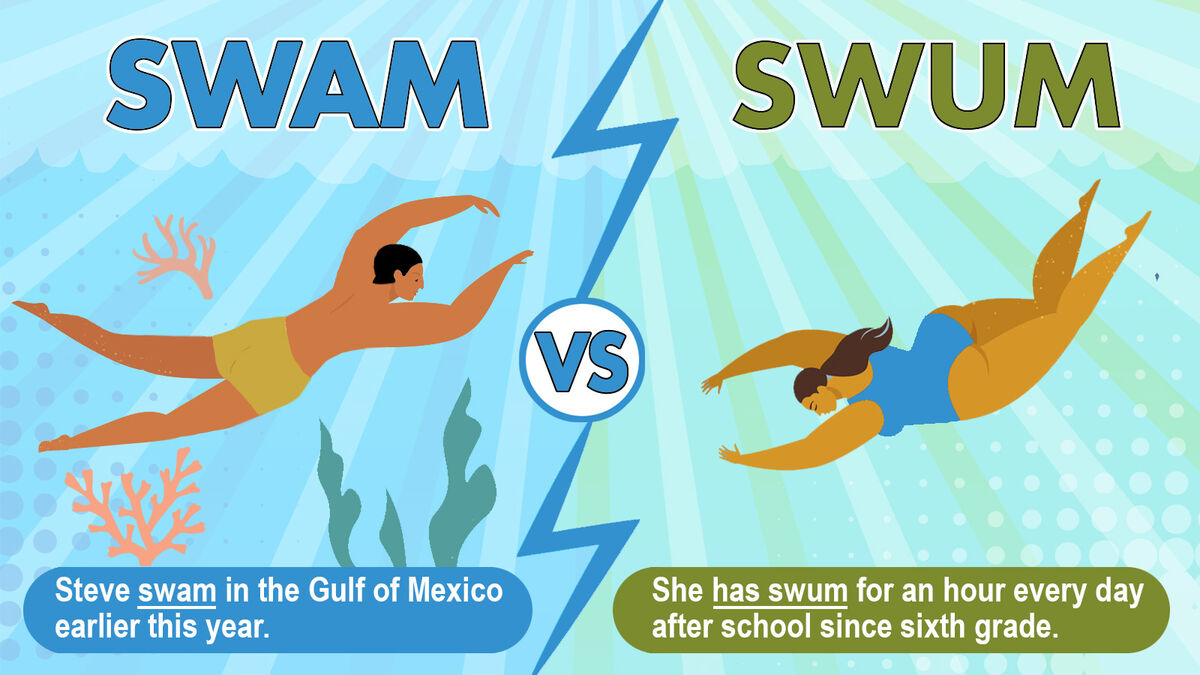
Knowing how to properly express the past tense of the word swim can be a bit confusing. In some cases, swam is the correct option, while swum is the proper choice in others. Discover what you need to know in order to make an informed selection between swam vs. swum in both written and spoken communication, as well as what to avoid.
Conjugating Swim: An Irregular Verb
While it’s easy to convert regular verbs to past tense just by adding an -ed to the end of the word, things aren’t so simple with the word swim. Since swim is an irregular verb; it doesn’t follow that predictable -ed pattern. Instead, you’ll need to use either swam or swum when referencing an act of swimming that took place in the past. Selecting the correct word from these two options depends on whether the context calls for past tense or past participle.
When to Use Swam
Swam is the past tense form of swim. This means that the word swam is correct when you are referring to action that took place in the past. Choose this way of expressing the past tense of swim any time the term does not follow the words has, have, or have.
- Steve swam in the Gulf of Mexico earlier this year.
- Lisa swam for two hours last Saturday during her time at the gym.
- The fish swam upstream.
When to Use Swum
Swum is the past participle conjugation of swim. This word should always be preceded by one of the auxiliary verb forms of the word have (has, have, or had).
- She has swum for an hour every day after school since sixth grade.
- By the time he graduated from high school, Daniel had swum in 15 junior championships.
- Once Tracy returns from her vacation, she will have swum in all of the oceans on earth.
Note: Swum is appropriate when speaking or writing in the past perfect, present perfect, or future perfect tense.
Let the Auxiliary Verb Be Your Guide
To help make it easier to decide whether to use swam or swum, reflect on whether there is an auxiliary verb form of have in the statement. Use this chart and related tip to ensure that your word usage is flawless.
Chart for Choosing Swam Vs. Swum
Whether you are writing or speaking, swam should never immediately follow has, have, or had, while swum should always follow one of these words.
Preceded by Has, Have, or Had? | Correct Choice | Application |
No | Swam | If you don’t say or write has, have or had, say swam. |
Yes | Swum | If you say or write have has, have, or had, say swum. |
Related Tip for Swum: Has vs. Have
In situations where you are using swum paired with a form of have, it’s important make sure you are using the correct auxiliary verb form (has, have, or had). Verify that you know how to choose the correct form of this verb by reviewing the grammar rules for conjugating have.
Do Not Use Swimmed
While people sometimes say swimmed, this term is not an example of proper word usage. At best, swimmed may be considered nonstandard terminology, though it is really considered to be incorrect. For all practical purposes using swimmed is just an error. It is sure to be perceived that way.
- Swimmed is a nonstandard term that should be avoided. Do not use it when speaking or writing.
- There is no context where it is considered correct to use swimmed as a word in the English language.
While people will realize that you are referring to an action of swimming that has occurred in the past if you say or write swimmed, using this terminology just does not reflect proper word usage. The fact that someone can figure out what a person means does not mean that the individual is using language properly.
Complexity of the English Language
Knowing when to use various forms of irregular verbs is just one illustration of the complexity that makes English a difficult language to master. Whether you are a native speaker or are learning to speak, read, or write English as a foreign language, it can be challenging to master things like pronoun usage, spelling challenges, and the many rules of grammar.
Master More Irregular Verbs
Swim is just one example of an irregular verb in the English language. Now that you can choose the best way to express the past tense of swim, it’s a great time to learn guidelines for more of the many irregular verbs in the English language. Review this extensive list of irregular verbs and reinforce what you learn by working through a few irregular verb worksheets. Mastering when to use swam vs. swim plus knowing to avoid swimmed is only the beginning. Soon you’ll be conjugating verbs at an expert level.